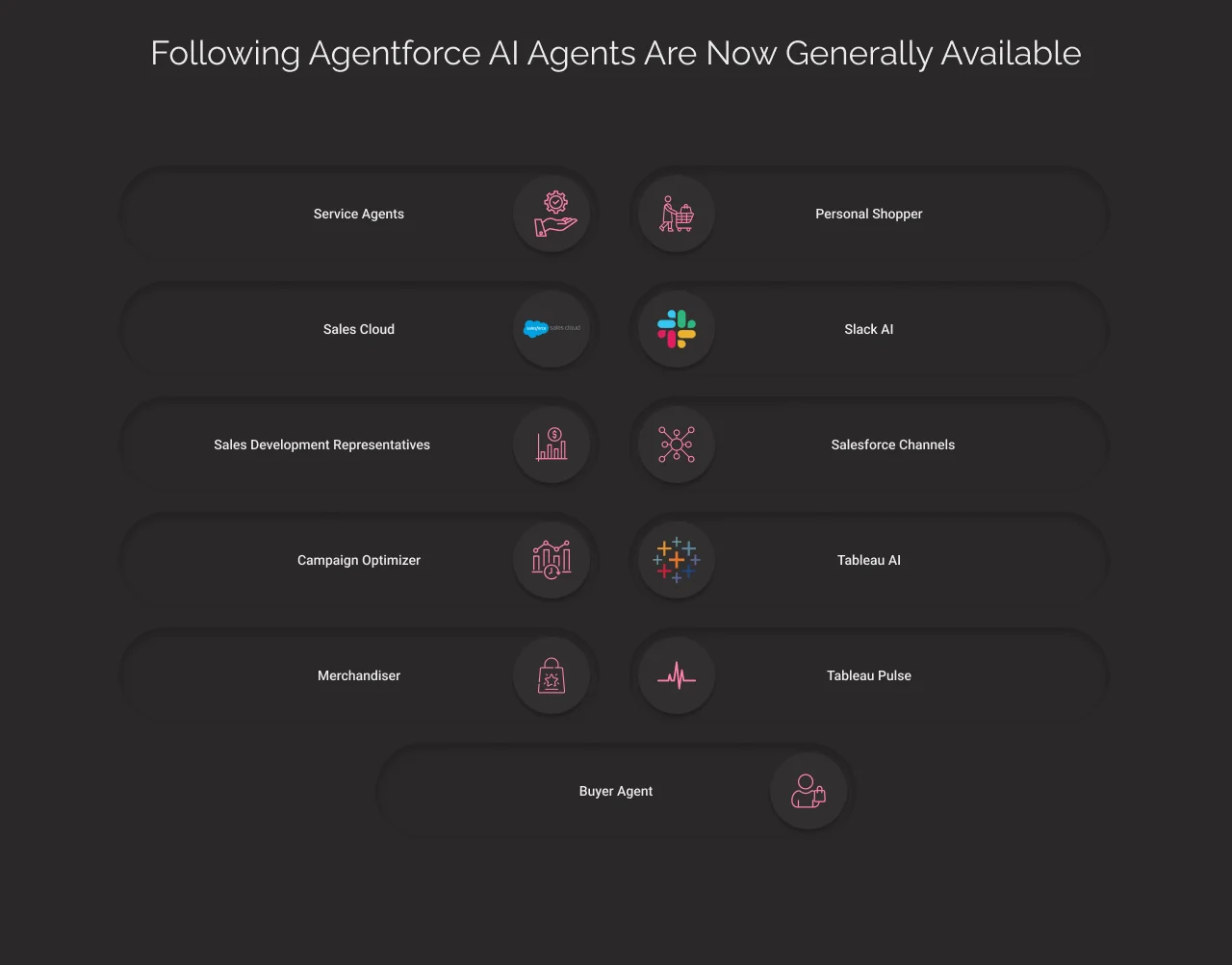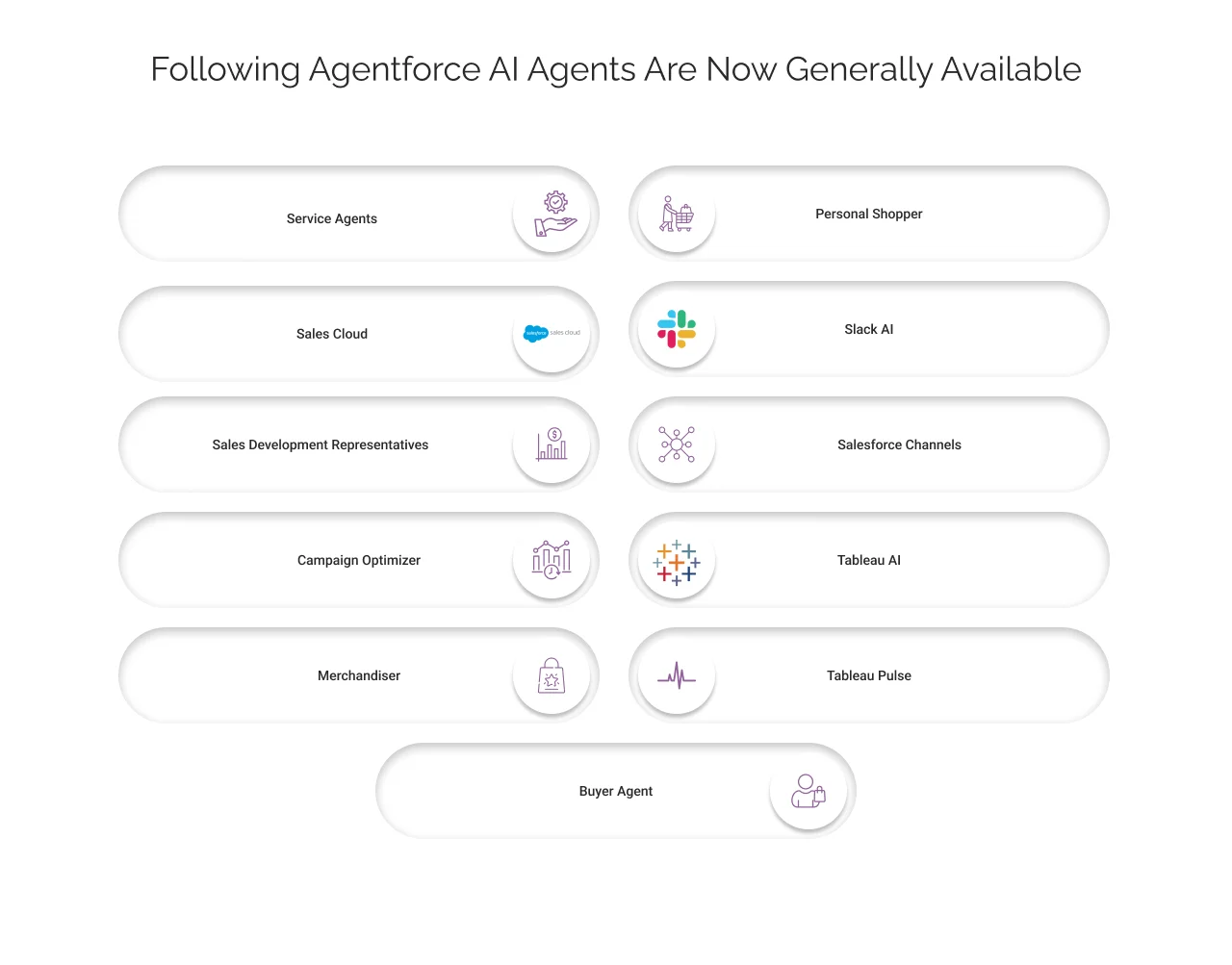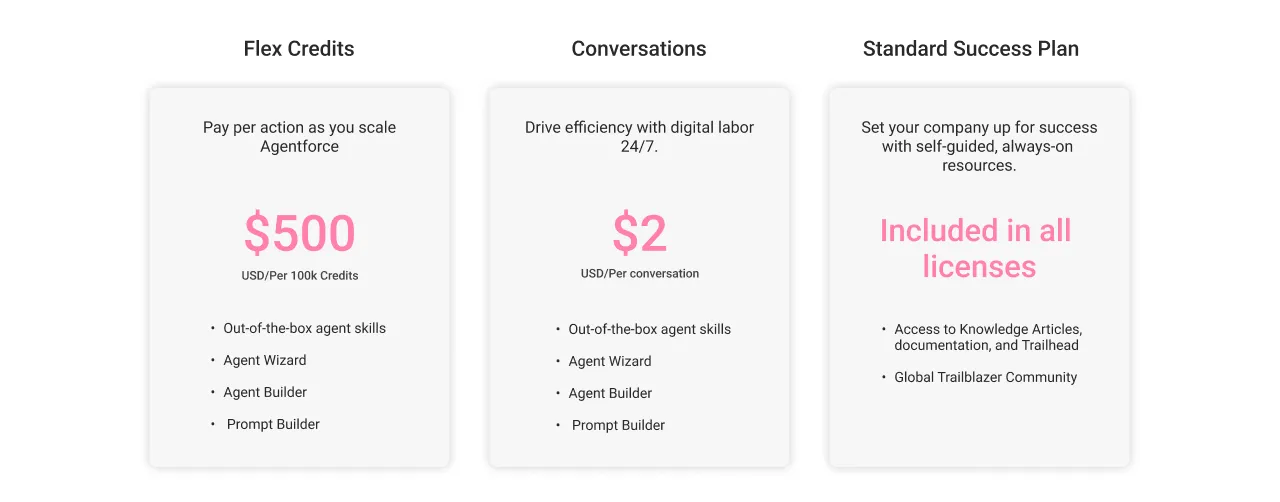What is Salesforce Agentforce? Everything You Should Know
Table of Contents
The first wave of AI promised intelligent insights. Second introduced assistance. And now the third wave of AI comes execution; an AI that doesn’t just recommend actions or insights but takes them with context, precision and accountability.
Salesforce calls this the Agentforce era, bringing a new generation of AI agents embedded into Einstein 1 Platform. These agents can handle tasks across Sales, Service, and Marketing like rescheduling meetings, updating CRM records, or escalating support cases, without human input and within the rules you define.
In this blog, we’ll explore what Agentforce is, how it works, how it brings AI, CRM and Data together and so much more.
What is Salesforce Agentforce?

Salesforce Agentforce is an AI platform that boosts agent productivity and customer satisfaction. It combines assistive AI, which helps with tasks like summarizing customer interactions and generating emails, with autonomous AI, which can make decisions and take action. This isn’t about replacing human agents but enhancing their abilities.
Agentforce integrates human, AI, customer data, and CRM for a smoother experience. It empowers businesses to build custom AI agents tailored to specific needs, automating tasks and providing real-time support.
Key Components to Build an Agentforce Agent
Here’s a breakdown of key elements that Agentforce comprises, along with insights on how to approach each one strategically.
1. Role: Defining Purpose and Scope
The Role component is the foundation of your agent, it’s similar to a job description. It clearly outlines:
- Primary Responsibilities and Objectives: What tasks will the agent perform?
- Specific Use Cases: Which scenarios will it handle?
- Target Audience: Who will interact with the agent?
- Success Metrics and Expected Outcomes: How will you measure its effectiveness?
For instance, a customer service agent’s role might be defined as “Provide first-line support for product inquiries while maintaining high customer satisfaction scores.”
Before understanding the Agent Builder, it’s important to conduct thorough research with your target users. The insights gained from this research should guide your decisions, ensuring that the agent’s purpose aligns with user needs.
2. Data: The Knowledge Foundation
Data acts as the brain of your Agentforce agent. This component includes:
- Access to Relevant Salesforce Objects and Fields: Ensuring the agent has the necessary data at its disposal.
- Integration with External Data Sources: Allowing the agent to pull in information from various platforms.
- Historical Interaction Data: Leveraging past interactions to inform future responses.
- Context-Specific Information: Providing relevant details based on user queries.
The quality and scope of the data you provide directly influence your agent’s decision-making capabilities. Remember the principle of Least Access: ensure that sensitive information is handled appropriately to avoid potential security breaches.
3. Actions: Enabling Response and Execution
Actions are what empower your agent to engage actively with users. This component encompasses:
- Pre-Built and Custom Functions: Tailoring actions to meet specific needs.
- API Integrations: Connecting with other systems for seamless operation.
- Workflow Triggers: Initiating processes based on user interactions.
- Automation Capabilities: Streamlining repetitive tasks.
Actions transform your agent from a passive information processor into an active participant in business processes, allowing it to create records, update data, and respond to queries effectively.
Even if you’re utilizing low-code tools and pre-built components, it’s essential to implement a formal DevOps process, including rigorous testing protocols.
4. Guardrails: Ensuring Safe and Compliant Operation
Guardrails are vital for maintaining safety and compliance in your agent’s operations. These mechanisms include:
- Data Privacy Controls: Protecting user information.
- Security Parameters: Safeguarding against unauthorized access.
- Ethical Guidelines: Ensuring responsible use of AI.
- Compliance Requirements: Adhering to legal standards.
- Response Limitations: Setting boundaries on what the agent can do.
Reviewing your data feed is crucial. In case certain information gets exposed, it could lead to a security breach, making implementation of robust guardrails imperative.
5. Channels: Enabling Multi-Platform Engagement
Channels dictate where and how your agent interacts with users. This component includes:
- Communication Platforms: Such as Slack, Email, or SMS.
- User Interfaces: The design and usability of interaction points.
- Integration Points: Connecting with other tools users may employ.
- Response Formats: How information is delivered back to users.
Effective channel configuration ensures that your agent is accessible in the environments where users need it most. Remember that testing must encompass all selected channels, testing in one platform (like Slack) does not guarantee functionality in another (like Microsoft Teams).
Agentforce is designed to enhance every aspect of customer interaction, whether it’s in sales, service, marketing, or commerce. This isn’t just about automating tasks; it’s about creating meaningful conversations that lead to genuine connections and higher conversions.
Agentforce is changing the foundational narrative of how businesses interact with customers.
What’s even more exciting is Salesforce’s vision of “Agentforce In Every App,” which means this technology can be integrated across various platforms, making it accessible to all facets of your business.
Technology Behind Agentforce: Customize your Agent
Here is the list of the technology behind Agentforces’ foundations:


1. Agent Builder
The low-key builder allows you to customize unique agents or even build your AI agents for any role, use case, or industry quickly. Organizations can create a job to be performed explicitly by agents by setting a topic, writing NLP-based instructions on that topic, and building a library of actions for agents to select from whenever needed.
Users can easily track the plan of actions to be executed by an agent and test their responses in Agent Builder.
2. Atlas Reasoning Engine
Known as the brain behind Agentforce Agents, it helps users to make agents revert naturally and adapt to scenarios as quickly as possible. This makes them ready to function faster, multi-task, and become more relevant to the team.
Atlas Reasoning Engine boosts agents’ accuracy and understanding of the assigned topics and classifies customers’ requests into a category with set scopes and rules, giving direction to agents on which actions they can take and which they can’t.
To help users effectively, each topic comes with clear instructions and actions. These might include checking order details or gathering additional information. The reasoning engine is designed to enhance this process by using advanced methods like Retrieval Augmentation Generation (RAG). This technique employs various language models to improve the quality of queries, ensuring that the most relevant information is retrieved while also assessing how good the responses are. Additionally, agents now have access to searchable public data, which further supports their ability to assist users.
3. Trust & Guardrails
Agentforce allows teams to create a clear set of rules or guidelines for their AI agents through simple and natural language. This helps in defining the topics an agent should handle and sharing precise instructions on when to escalate a query to a human agent. By establishing these guardrails, teams ensure that the agents operate effectively in their respective assigned roles.
Suppose a customer inquiry exceeds the AI agent’s capabilities. In that case, it can be easily handed off to a human representative, summarizing the conversation and providing essential details to make the conversation smooth.
Additionally, Agentforce prioritizes data security through the Einstein Trust Layer, which ensures that no Salesforce data is accessed or retained by third-party AI model providers, allowing organizations to use large language models (LLMs) safely. With these robust security measures in place, users can confidently deploy AI agents that can autonomously manage a variety of tasks simultaneously having the conscience to escalate more complex issues to human experts when necessary.
4. Model Builder
Model Builder is a user-friendly, low-code tool that gives customers an easy way to register, test, and activate their custom AI models and large language models (LLMs) inside their Salesforce Org. Users can get the API keys for their preferred LLMs, experiment in their testing environment, and activate these models when it feels like using Prompt Builder, enabling businesses to customize their AI solutions and integrate them seamlessly into their Salesforce experience.
5. Prompt Builder
The prompt is the first step toward the creation of a generative experience. An excellent prompt builder makes it easy for users to personalize ready-to-use prompt templates with their own CRM or data available in Salesforce Data Cloud, improving the quality of results.
The Prompt Builder integrates the generative experience into everyday tasks, whether it’s part of an automated workflow, a Lightning record page, or even in the actions performed by an agent. This way, users can enhance their work processes while receiving more relevant and tailored outputs.
Why Agentforce?
Here are the top reasons companies are turning to Agentforce and why it matters beyond the surface.
1. Native to Salesforce CRM
Agentforce works inside the Salesforce ecosystem, not on top of it. AI Agents have direct access to customer records, opportunity pipelines, case data, etc. And they do it without the need for sync jobs or external APIs. This allows decision makers to take actions in real-time, based on the most accurate and complete picture of the customer.
2. Smarter Search with RAG and Semantic Understanding
This innovation from Salesforce uses Retrieval-Augmented Generation (RAG) and semantic search capabilities. It enables AI agents to locate, process, and act on data collected from various sources. This allows them to handle more complex queries and makes them useful not just for task execution, but also for intelligent support and analysis.
3. Zero-Copy Data Access via Salesforce Data Cloud
Agentforce works best when integrated with Data Cloud. AI agents can access external data sources without copying data into Salesforce. This zero-copy approach enhances system efficiency, respects compliance boundaries, and removes unnecessary duplication, giving agents a broader context while maintaining data integrity.
4. Context-Aware Task Execution
It doesn’t just automate steps. Each agent is aware of the who, what, when, and why behind the task it’s executing. This context helps it act accurately and respond intelligently. It’s especially useful in workflows that rely on detailed business logic or customer-specific actions.
5. Built-In Governance and Safety Controls
AI agents within Agentforce follow organization-defined guardrails. These include permissions, task boundaries, and built-in safety checks like toxicity detection. This helps businesses in regulated industries adopt AI safely. They don’t have to worry about governance after deployment.
6. Better Customer Experiences
When AI resolves inquiries and performs routine actions, customers don’t have to wait. Agentforce enables instant, accurate responses, allowing employees to focus on more complex interactions. This improves responsiveness and overall service quality.
7. Real-Time Coaching for Sales Teams
Agentforce doesn’t stop at support tasks. It can also guide sales teams in real time, offering on-the-spot feedback, data insights. It can also recommend actions based on live interactions. That support can lead to more productive conversations and more closed deals.
8. Designed for Scalability and Flexibility
Whether you’re managing a growing workload, expanding into new markets, or layering on new data sources, Agentforce is built to scale. Its architecture supports multi-agent orchestration, integration across Salesforce Clouds, and flexible extensions into third-party systems.
9. Lower Operational Costs
Agentforce automates recurring tasks and cuts down manual work. This helps teams achieve more while using fewer resources. Its flexible pricing, starting as low as $2 per conversation or $0.10 per action, makes it cost-effective for both small teams and large-scale operations.
10. Continuous Learning Built In
Agents learn over time. Based on past interactions and real-world outcomes, agents become more efficient and relevant with continued use. This ongoing improvement compounds the platform’s value, especially in dynamic or data-heavy business environments.
For organizations using Salesforce as a core platform, Agentforce offers a clear path forward to smarter operations, all powered by AI, governed by design, and built for business growth.
Agentforce is the Only One to Bring Human + AI + Data + Actions


Here is what happens when it takes charge of the following:
Human + AI
The most effective way to utilize AI agents is by having them work peacefully with humans and witness your customer experience reaching heights. These assistive agents handle time-consuming tasks, freeing up employees to focus on higher-value activities that contribute more to the revenue generation side.
Additionally, autonomous agents also proactively manage specific tasks and escalate issues to human team members when necessary. For example, every new Account Executive (AE) can get trained by a personal sales coach who provides feedback, guidance, and support to help them excel in their roles.
Data
For AI agents to perform effectively, they need access to the correct data from trusted sources at the right time. With Salesforce Data Cloud, the team can create intelligent agents that have the necessary information for any employee or customer interaction.
It enables users to leverage data from all parts of their organization, ensuring scalability and security while keeping up with enterprise-grade standards. This setup allows agents to be dynamic in the case of business processes and customers without putting data security in jeopardy.
Actions
An AI agent that cannot take meaningful action is just another bot. Agentforce agents are designed to perform actions across various systems, empowering teams to deliver tasks more efficiently. These agents establish a connection between data and action by revealing metadata about defined workflows and AI automation, which empowers them to undertake high-value tasks.
How does Salesforce Data Cloud Empower Agentforce?
Salesforce Data Cloud is at the heart of what makes Agentforce truly exceptional. It brings together all kinds of data, both structured and unstructured across different sources in real time.
This collaboration allows users to create a complete picture of customers and deliver personalized experiences that people didn’t see coming but will surely love, wherever they are (irrespective of communication channels and different touchpoints).
Here’s how Data Cloud is set to back Agentforce up:
Seamless Integration with Customer 360
With Data Cloud, Salesforce Customer 360 applications can tap into reliable customer data, which is essential for crafting personalized experiences and gaining real-time insights. Zero-copy technology and MuleSoft connectors are the technology behind Data Cloud, which is going to help pull data from different sources, including data lakes and warehouses.
It can also transform various formats like PDFs, texts, and videos into useful information, creating detailed customer profiles stored as metadata. This metadata flows smoothly into Salesforce applications, giving every team a 360-degree view of the customer while keeping data secure.
With the belief in an open ecosystem that encourages customization, Salesforce has made it easy for users to create custom connectors and extend features. And the recent acquisition of Zoomin is the reason behind it. Here’s how: Zoomin helps Data Cloud to integrate unstructured content, allowing access to valuable enterprise knowledge from platforms like Google Drive and Microsoft SharePoint.
Contextual Data for Agentforce
Data Cloud uses advanced features like Retrieval Augmented Generation (RAG) and hybrid search to provide meaningful insights for Agentforce. RAG helps find the right data from various sources, while hybrid search combines semantic understanding with keyword searches to deliver precise information. The introduction of no-code retrievers makes it simple for users to set up customized data retrieval processes without needing technical expertise.
Thanks to its integration with the Atlas Reasoning Engine, Data Cloud allows agents to extract valuable insights from complex unstructured data. For example, Agentforce can connect product details found in customer images to relevant knowledge articles, helping support teams resolve issues more efficiently.
Autonomous Actions in Workflow
Data Cloud makes it easy for business users to access actionable data when they need it. This capability empowers sales teams to spot upsell opportunities and enables service teams to proactively meet customer needs. By making data accessible to everyone, Salesforce helps teams use insights to create more targeted interactions with customers.
Data Cloud takes things a step further by turning insights into immediate actions through integrated analytics and automation. With real-time capabilities, it supports Einstein Personalization and AI-driven recommendations that help teams make quicker decisions across various customer touchpoints. Automation through data-triggered workflows streamlines operations, while low-code tools ensure that everyone in the organization can easily access and act on data.
Agentforce leverages machine learning and generative AI insights from Data Cloud to deliver personalized recommendations. This means timely engagement with customers happens seamlessly across different channels like Slack and Tableau.
AgentExchange
AgentExchange is Salesforce’s new marketplace for AI agents. It is a platform that is built to help businesses find prebuilt templates, prompts, and components that work right inside Salesforce, making it easier to automate tasks across sales, service, HR, and other processes, without heavy development.
With support from over 200 partners like Google Cloud, DocuSign, and Box, AgentExchange brings together solutions tailored to real business needs. It’s a practical way to scale AI with less effort. Learn how Agentforce 2DX makes this possible.


Agentforce AI Agents In Action
In addition to this, the following Agentforce AI agents are now generally available:


| Generally Available Agentforce AI Agents | ||
|---|---|---|
| Service Agents | Sales Cloud | Sales Development Representatives |
| Campaign Optimizer | Merchandiser | Buyer Agent |
| Personal Shopper | Slack AI | Salesforce Channels |
| Tableau AI | Tableau Pulse | |
That’s not all that Agentforce has to offer. More operation-based and industry-based agents are expected to roll out soon.
A few components of Atlas Reasoning Engine will be available in February 2025.
Agentforce Pre-Built Agents To Cater to Your Custom Needs
Agentforce offers a range of AI agents designed to enhance various aspects of business operations, from customer service to sales and marketing. These agents are built to handle a wide variety of tasks, adapting to each situation without relying on pre-programmed scenarios.
1. Service Agent
Service Agent is expected to be a suitable replacement for traditional chatbots, providing highly efficient customer service. The Sales Development Representative (SDR) interacts with customers 24/7, answering questions, addressing issues, and scheduling meetings based on CRM and external data.
2. Sales Coach
The Sales Coach uses data present in Salesforce and generative AI to provide personalized role-play sessions for sales teams, training them to polish their pitches and query-handling capabilities specific to deals. The Merchandiser assists ecommerce merchandisers with site setup, goal setting, personalized promotions, product descriptions, and data-driven insights, simplifying their daily tasks.
3. Buyer Agent
The Buyer Agent helps businesses refine the B2B buying experience by assisting customers to find ideal products, make purchases, and track orders via chat or within sales portals. The Personal Shopper serves as a digital concierge on ecommerce sites or messaging apps, offering personalized product recommendations and assisting with search queries.
4. Campaign Optimizer
Campaign Optimizer is another agent that automates the entire campaign lifecycle. It uses AI for analyzing, generating, personalizing, and optimizing marketing campaigns based on business goals. Finally, Agentforce (formerly Einstein Copilot) supports teams in the flow of their work by searching for data, creating action plans, and executing them to increase workplace efficiency.
By using these AI agents, businesses can make their operations less hectic, enhance customer experiences, and increase productivity in different departments.
Empowering Businesses with Autonomous Agents: Tailored Solutions for Every Industry
You can easily create agents from scratch using familiar Salesforce tools like prompts, flows, Apex, and APIs to meet your specific requirements. Following are some use cases for Agentforce:
Healthcare Agent:
This agent interacts independently with patients, healthcare providers, and insurance companies to answer questions, provide summaries, and take action across various communication channels.
Banking Agent:
A banking agent analyzes data on its own, manages client requests proactively, and offers personalized services in retail, commercial, and investment banking.
Retail Agent:
With the help of a retail agent, you can share insights from marketing campaigns independently, manage customer outreach proactively, and resolve issues for fashion, grocery, and convenience stores.
Operations Agent:
This agent helps operations teams by managing planning tasks, identifying resource needs, and tracking progress across different teams.
CX Agent:
A Customer Experience agent reviews customer surveys and feedback on its own suggests ways to improve customer retention proactively and manages experiences across multiple channels.
Analytics Agent:
An analytics agent shares important data insights independently, creates visual representations of data and recommends actions based on the findings.
IT Agent:
This agent monitors security threats on its own, provides insights about the network, and resolves support issues for both customers and employees.
Finance Agent:
A Finance agent offers insights into financial reports and risk assessments independently, detects potential fraud, and addresses compliance-related questions.
Agentforce Pricing: A Detailed Break-down
Now, let’s discuss how much Agentforce costs.
Originally, Agentforce was launched with a flat $2 per conversation pricing model, where a “conversation” was defined as a 24-hour AI-to-human interaction window. This model posed limitations to enterprises with high interaction volumes.
For example, a support team running 10,000 AI-led conversations per month would incur a cost of $20,000, regardless of whether those conversations drive any value or close any tickets. It lacked cost granularity and expanding budget unnecessarily at scale.
To address this, Salesforce recently introduced a consumption-based model to match pricing with actual AI usage.
1. Flex Credits
Flex Credits are Salesforce’s unit-based currency for Agentforce’s pay-per-action pricing model. They represent the micro-units of AI agent usage, each time an agent performs a task, it deducts a set number of credits from your purchased pool. These actions can be updating a record, generating a summary, classifying a case or creating a task. This enables businesses to measure and pay for value created, not just interactions initiated.
| 20 Credits | 1 AI Agent Action |
| 100,000 Credits | $500 |
| Cost Per Action | $0.10 |
2. Flex Agreements
In order to help businesses with budget control, Salesforce also launched Flex Agreements. It is a contractual framework that allows organizations to manage spending between human user licenses and AI usage (via flex credits) as your needs change. You don’t need to change contracts and pay any penalties with this agreement.
It’s a smart move for CIOs and CFOs who want the flexibility to balance people and automation as the business evolves.
What Enterprises Must Know Before Scaling Agentforce
Agentforce provides strong automation at scale. However, scaling it well needs more than just activation. Behind the scenes are key factors that affect cost, scalability, and success. Here’s what enterprises need to consider before rolling it out widely.
1. Enterprise Edition Is a Prerequisite
Agentforce only works with Enterprise Edition and above. If you’re on a lower plan like Professional or Essentials, you’ll need to upgrade to access any Agentforce capabilities. This can impact your overall cost and it must be planned early, especially if you are mid-sized businesses still growing your Salesforce setup.
2. Real-Time Consumption Visibility via Digital Wallet
Salesforce provides a Digital Wallet dashboard to track Flex Credit usage in real time. For IT and operations leaders, this is critical. It offers transparency into what actions are consuming credits. It also allows early detection of unnecessary automation, and supports ongoing governance over AI usage. Without this, costs can quietly accumulate in the background.
3. Unlimited Internal Agent Usage Through PUPM Licenses Only
Salesforce provides per-user-per-month (PUPM) licenses for tasks like automating internal support, sales enablement, and HR. These licenses allow unlimited AI agent activity. This model works best for changing or high-volume internal tasks. Pay-per-action models can lead to unpredictable costs in these situations.
4. Multi-Channel Agent Deployment Is Built In
Agentforce agents aren’t confined to Salesforce’s UI. They can be deployed across Slack, Service Cloud, Field Service, or even embedded into custom apps and portals. This lets businesses use Agentforce across different workflows and user touchpoints. But remember, you will need to coordinate carefully to avoid duplicate efforts or confusion.
5. High-Volume Use Cases Require Governance
While each AI action costs only $0.10 (20 Flex Credits), that figure scales quickly. A use case consuming 360,000 actions monthly results in a $1,800 expense. Multiply that across departments, and it’s easy to see how fast costs can spiral. Enterprises must put guardrails and oversight in place to ensure Agentforce is deployed with purpose, not just novelty.
Agentforce General Availability
The revised Agentforce pricing is generally available as of May 15, 2025, with flexible deployment options across industries and functions.


Pricing Overview Table
| Model | Details | Cost | Best For |
|---|---|---|---|
| Per Conversation (Legacy) | Flat $2 per 24-hour AI-to-human interaction window | $2 per conversation | Simple pilot use cases, now largely deprecated |
| Flex Credits | Pay-per-action; 20 credits per action | $500 for 100,000 credits | Scalable, cost-aligned AI adoption |
| Flex Agreement | Budget portability between user licenses and Flex Credits | Variable (contract-based) | Dynamic budget alignment for hybrid human+AI teams |
| User License Add-On | Unlimited internal AI usage (PUPM model) | Based on license tier | High-volume employee use cases like HR, sales ops |
| Edition Requirement | Available with Enterprise Edition and above | Upgrade may be required | Medium–large enterprises investing in advanced AI |
Salesforce’s Agentforce new pricing isn’t just about cost, it’s a shift in how businesses must approach AI budgeting. As digital labor becomes as important as human labor, success now depends on clearly deciding:
- who does what,
- tracking AI usage, and
- managing costs with intent.
It’s not about if you’ll use AI—it’s about how smartly you’ll manage it.


The Final Take
To wrap it up, trusting and immersing your business processes and systems in this third wave of AI revolution can be both exciting and challenging. Being the no-code solution, Agentforce promises quick setups, but customizing agents to perfectly fit your business needs might call for extra: time, effort, and expertise.
You can find both effort and expertise at Cyntexa. As a part of the Agentforce Partner Network and a trusted Salesforce Summit Consulting Partner, we have a team comprising 400+ experts, including more than 170+ AI associates and 70+ AI specialists (and it’s just the beginning). With our Agentforce consulting services We can help you securely build and deploy agents that are ready to hit the ground running.
Agentforce isn’t just another AI-based offering; it is expected to be a ground-breaking combination of AI with the personal touch that customers like. Whether you want to grow your service team or make your current work easier, Agentforce is the tool you need by your side.
Curious about how Agentforce can make a difference for your company?
Schedule a consultation with Cyntexa’s experts and get started on your AI journey!
Don’t Worry, We Got You Covered!
Get The Expert curated eGuide straight to your inbox and get going with the Salesforce Excellence.
AUTHOR
Shubham
Service Cloud, Salesforce Managed Packages
With over 5 years of experience, Shubham specialize in curating solutions on Salesforce Service Cloud, Nonprofit Cloud, Consumer Goods Cloud, Managed Packages, and ServiceNow ITSM. He designs and implements end-to-end service solutions that improve operational workflows and ensure seamless integration across enterprise systems. Shubham’s expertise lies in creating secure, efficient, and agile platforms tailored to unique business needs.


Cyntexa.
Join Our Newsletter. Get Your Daily Dose Of Search Know-How
Frequently Asked Questions
Agentforce deploys autonomous AI agents to perform various business functions like sales, service, and marketing. These AI agents utilize real-time data to adapt to changing conditions and can take actions independently, eliminating human intervention. They work within customized guardrails, ensuring that tasks are completed accurately and securely while allowing for seamless integration with human employees when necessary.
It helps businesses by improving sales and customer service with 24/7 AI support, managing costs through automation, and providing real-time unified data for strategic decision-making. It encourages teamwork, easily grows with your needs, introduces new ideas, and helps you stand out by offering better products and services.
Agentforce offers specialized AI agents catering to different business operations. These include Agentforce Service Agent, which autonomously resolves customer inquiries. Next is Agentforce Sales Development Representative (SDR), who engages with inbound leads and schedules meetings, and Agentforce Sales Coach who can train account executives and provide role-playing sessions. We also have a Merchant agent, assisting e-commerce teams with product management. Each agent is designed to operate independently while integrating seamlessly with existing workflows.
AI agents can assist in various business processes, including customer engagement, sales representative training, customer service, marketing campaigns, and eCommerce operations. These agents align workflows by implementing automation for boring tasks like answering inquiries, qualifying leads, scheduling appointments, and suggesting personalized recommendations. This versatility enables organizations to increase efficiency across departments while delivering a better customer experience.





